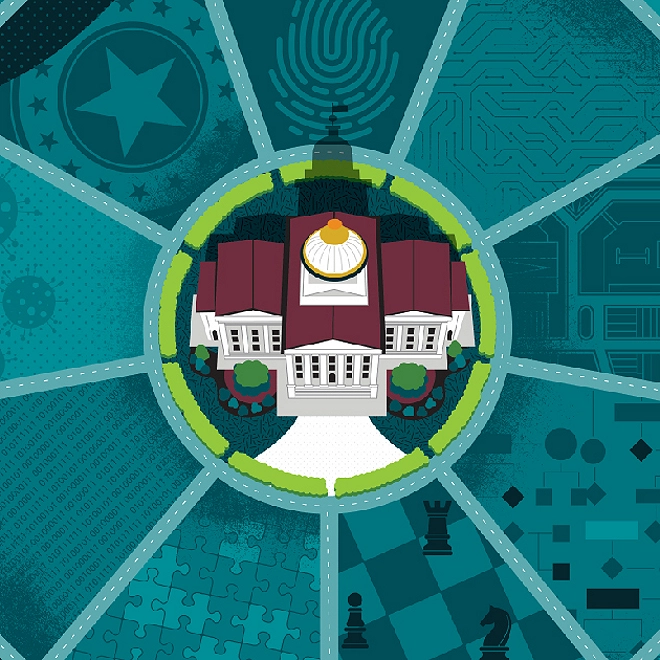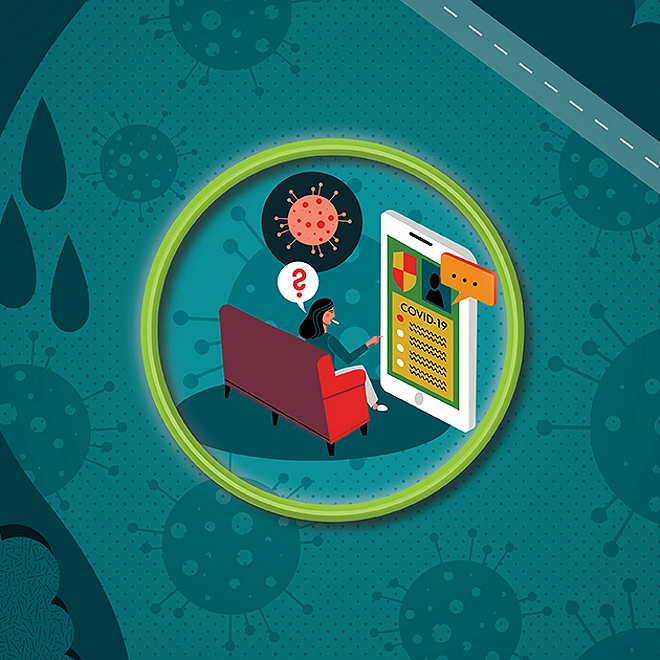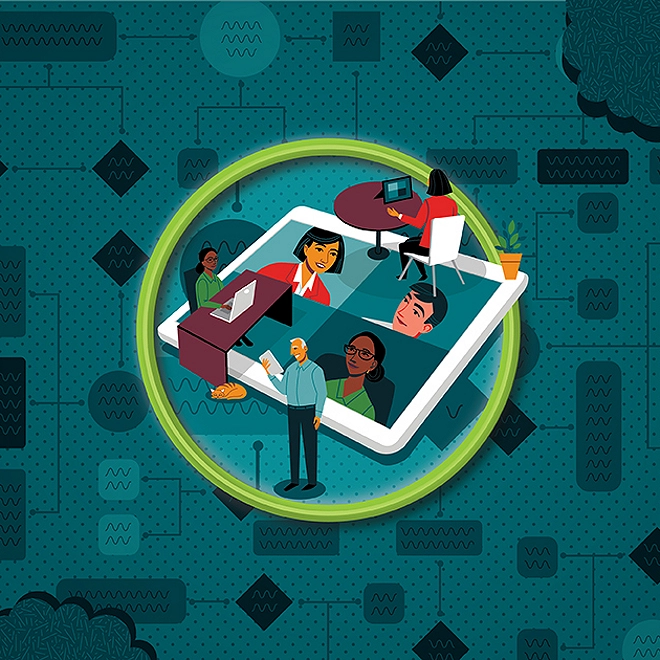Fluid data dynamics
Generating greater public value from data
The power of data-sharing is well documented. Sharing data can save time, money, and lives. Data is becoming increasingly critical to problem-solving and decision-making. As governments are turning into more insights-driven organizations, they are becoming more fluid in their ability to get data in ways they can do the most good.
The COVID-19 pandemic is a prime example of these more fluid data dynamics. During the pandemic, government shared data widely. From the European Union setting up a regionwide interoperability gateway to enable a secure information exchange between different national contact-tracing apps, to the US National Institutes of Health establishing a centralized repository of COVID-19 health records for facilitating research and discovery, the rapid sharing of data proved instrumental to the public sector pandemic response.1
The pandemic merely accelerated the trend of sharing data that was already underway. Increasingly, government has been leveraging data to respond to public challenges, with three trends in particular growing:
- Building exchanges to accelerate data sharing—Public agencies are establishing specialized data portals to share data with other government agencies, community groups, and industries.
- Facilitating FAIR and standardized data—Governments are adopting FAIR principles (findable, accessible, interoperable, and reusable) to ensure public data can be accessed efficiently. They’re also creating frameworks that standardize data to allow for greater interoperability.
- Redesigning data governance—The demand for more data-sharing is prompting governments to revisit data governance, redefine the parameters of data ownership and data quality standards, and strengthen data protection.
Building exchanges to accelerate data-sharing
Getting the greatest value from their data is becoming a top priority for governments across the globe. The data strategies of countries such as Australia, Ireland, Canada, the United Kingdom, and the United States include data-sharing and reuse as a vital component.2 There are three key conduits accelerating data-sharing:
- Specialized data-sharing platforms
- Intragovernmental data corridors
- Cross-industry data corridors

Specialized data-sharing platforms
Public agencies are setting up specialized data exchange portals that allow for data-sharing between different entities for a wide range of purposes. From improving administrative processes to advancing research to simply boosting transparency, these data-sharing platforms can greatly enhance public services.
For instance, health information exchanges are gaining ground in the public sector, especially in the wake of the COVID-19 pandemic. These exchanges can greatly facilitate the sharing of patient data, which is crucial to delivering appropriate care. In the United States, the Department of Veterans Affairs built the Veterans Health Information Exchange, which gives health care providers seamless and secure access to veterans’ personal health information. The exchange eliminates the need for veterans to collect and share paper medical records, typically by mail or in person.3 Similarly, in the Netherlands, the Ministry of Health, Welfare, and Sport is part of a collaborative effort that has developed a portal that enables Dutch hospitals to exchange COVID-19 patient information.4
Recently, a number of countries have launched exclusive platforms to share COVID-19 data with researchers. For instance, the European Union’s COVID-19 Data Portal and the United States’ National COVID Cohort Collaborative (N3C) allow scientists and researchers to store, share, and access clinical COVID-19–related data sets.5
Intragovernmental data corridors
Data held by government has often been kept in silos. Moreover, a lack of common standards has sometimes limited agencies’ ability to exchange information. But this is beginning to change. For instance, Estonia’s government has built a robust data exchange layer to successfully enable the “once-only” principle—allowing citizens to share information just once with government.6 Other governments are beginning to take a similar approach, setting up specialized data corridors to enable information-sharing between agencies.
For instance, Singapore’s self-service, centralized data-sharing platform, APEX, facilitates data reuse between agencies and approved businesses. Data collected and stored by one agency can be used by those who have a legitimate use for it. Citizens can fill out just one form for a variety of secure online transactions, from opening a bank account to applying for a home.7 Similarly, the Malaysian government’s Central Data Exchange has been developed to increase coordination within the public sector, ensure information is accurate and up to date, and improve government service delivery through speedier data access.8
In another example, Cambodia’s Data eXchange is a decentralized platform that permits confidential data-sharing between authorized institutions; it, too, employs a “once-only” model to reduce administrative burden and improve data consistency.9
Cross-industry data corridors
Governments can also play a convening role, bringing together different entities to enable data exchange between government, industry groups, and academics, providing a platform to ensure robust, secure, and controlled data transactions. In many cases, accessing pre-existing data is more cost-effective and less burdensome than collecting new data through government surveys. As a result, governments are increasingly partnering with other stakeholders and forming data ecosystems to facilitate cross-industry data exchange.10
Consider the case of the Amsterdam Data Exchange (Amdex), a data marketplace in the Netherlands. Initiated in 2018 and supported by the City of Amsterdam, the collective includes the Amsterdam Economic Board, Amsterdam Science Park, and Amsterdam Data Science. Amdex aims to truly democratize data by breaking data siloes and providing researchers, businesses, governments, and citizens with trusted and secure data transactions.11
In another example, the United Kingdom’s Cyber Security Information Sharing Partnership, a collaborative between the industry and the government, is a national-level platform that facilitates secure and controlled cyber information exchange across organizations. By allowing its members to share cyberthreat information in real time, the platform was designed to help provide early warning signs and build better preparedness.12
Also, multilateral organizations such as UNICEF have invested in the data-sharing platform Magic Box, through which private sector partners can share real-time data to enable better humanitarian response. UNICEF has cited school-mapping, household poverty, epidemic response, and natural disaster mitigation as some of the platform’s potential applications.13
Facilitating FAIR and standardized data
Building exchanges is only one way that government is becoming more dynamic in its use of data. While data-sharing is critical, it is also important to improve the quality of the data being shared. In many cases, this means putting it in formats that are FAIR. The FAIR principles put specific emphasis on the ability of machines (rather than humans) to automatically find and use data—in other words, making data “machine-actionable.” Ultimately, this makes the data more useful for researchers and supports innovation.14
Governments are increasingly encouraging the exchange of FAIR data—in standardized, interoperable formats through web-based tools and the cloud.15 Virtual biomedical data commons, where scientists can store, access, and share biomedical data and tools, are based on FAIR principles, for instance. Here, researchers can collectively work on “digital objects of biomedical research” and apply cognitive computing capabilities in a single cloud-based environment.16 In a similar vein, the National Cancer Institute’s Genomic Data Commons in the United States is a platform that supports precision medicine. It provides tools that allow users to share, access, and analyze both genomic and health data as inputs for cancer genomic studies.17
In another example, the European Open Science Cloud (EOSC), a digital platform that promotes data-driven science, is also guided by FAIR principles.18 The EOSC portal provides the scientific community with open access to data in a variety of disciplines (medicine, arts, and agriculture, to name just a few) while supporting interoperability of data sets from multiple providers.19
Because data standardization is critical to achieving interoperability of data, public agencies are establishing data standards either at a national level or backing similar initiatives at a global level. The Global Alliance for Genomics and Health, for example, is an international organization, funded by both public and private entities from different regions, that develops frameworks to address barriers to health-related data-sharing at an international level.20
Greater data fluidity can benefit governments in many ways. Austria’s central bank, the Oesterreichische Nationalbank, has an innovative approach to regulatory reporting based on better data exchange. Thanks to a common platform that standardizes data into small units known as “basic cubes,” Austrian banks can deliver microdata in the form of individual contracts, loans, or deposits. This approach facilitates the reusability of this data and has reduced the cost of regulatory reporting in Austria by more than 30%.21
On a related note, governments are also using application programming interfaces (APIs) to improve access to data and discourage multiple copies of a single data set. These APIs are proving to be crucial in enabling secure data exchange across government agencies.22 A number of nations including Ireland, Portugal, and the Netherlands use APIs to enable data-sharing and reuse at various levels of government.23
API strategies and standards are also being designed and developed at a national level to ensure a standardized interface design between multiple systems.24 The UK Government Digital Service developed a set of common API standards to be implemented across the government.25 Likewise, the Canadian government’s API Store is a catalog of government APIs that assist with findability by enabling users to browse and explore data and services.26
By creating standards that make data more standardized and easily shared, governments are making data a more powerful tool. But what about ensuring privacy or securing data? Government’s move toward fluid data dynamics demands new forms of governance.
Redesigning data governance
The growing revolution in data is challenging how we think about the use of data in service of a greater good. The COVID-19 pandemic forever changed the risk/reward equation, tilting it in favor of sharing over hoarding. The pandemic also raised important questions about data governance. As the dynamic flows of data increase, there will be greater pressure for robust data governance frameworks that define data ownership, protect privacy, and, at the same time, promote transparency.
Our 2020 Government Trends report provided a detailed account of how governments are tackling the ethical complexities of the age of big data, including ethical algorithms for decisions guided by artificial intelligence.27 Beyond such data ethics, however, data governance will be key to promoting privacy by design and ensuring that ownership of data is defined appropriately.
Defining data ownership and control
Data ownership is a complex concept. If I have data about you in my database, who owns that data? Does it depend on what kind of data it is? For example, if I know you just bought a new boat, can I sell that information? What if I know you were just diagnosed with cancer?
According to a 2018 survey, 90% of respondents believe it is unethical to share data about them without their consent, highlighting growing concerns surrounding data control and ownership.28 Bearing this in mind, and recognizing the importance of building citizen trust, some governments have begun to establish frameworks to give citizens greater control over their data.29 For instance, in January 2020, Indonesia’s government submitted a bill to parliament that would require explicit consent to distribute personal data such as name, nationality, religion, sexual orientation, or medical records. Violators could face up to seven years in jail for sharing citizen data without consent.30
Another governance approach is shown by the UK National Health Service (NHS). In the COVID-19 app of the UK NHS, the Department of Health and Social Care, NHS England, and NHS Improvement are the designated data controllers. Those agencies can determine the purpose of data collection, decide whether data should be further shared, set the duration for which an app can retain the data, and more.31
Estonia’s X-tee platform—formerly known as X-Road—gives citizens significant control over how data about them is used. To ensure privacy, the platform uses blockchain technology to exchange data, which can only be accessed by authorized users.32
Promoting privacy by design
As data-sharing grows, so do privacy concerns. To protect against potential security breaches, governments are increasingly embracing a concept knows as “privacy by design,” which incorporates security features during the initial design stages of products and processes.
Privacy by design is gaining global acceptance. Canada has been a pioneer since the 1990s, and Canadian experts have helped develop international standards for privacy by design.33 The European Union’s General Data Protection Regulation mandates all organizations adopt privacy by design.34
In Australia, the Office of the National Data Commissioner endorsed a privacy by design approach when developing legislation. The office emphasized the importance of considering privacy during every stage of legislative development and is working with experts to develop a framework for safe data-sharing.35
India’s Aadhaar ID system was designed with front- and back-end tokenization to safeguard user data. Different agencies receive different tokens for the same person, preventing information linking across databases.36 The system additionally allows users to create a temporary virtual ID, which they can provide instead of their Aadhaar number.37
Data signals
- The European Commission’s projections suggest a 530% increase in global data volume during 2018–2025.38
- According to Organization for Economic Cooperation and Development (OECD) estimates, the social and economic benefits of public sector data access and sharing can range between 0.1% and 1.5% of GDP.39
- Estonia’s X-Road helps government and citizens save approximately 844 years of working time annually.40
Moving forward
- Build an insights-driven organization. Data and analytics can drive decision-making and keep data at the core of digital transformation.
- Reset default to share. Government leaders should start with the expectation that data has value in the public interest and will be shared.
- Develop an appropriate talent mix. Stand up a multidisciplinary team with technical skills such as statistical analysis, data science, and data management and with soft skills such as communication, critical thinking, and business acumen.
- Reward-sharing and resharing. Incentives in the form of funding and career advancements should be focused on celebrating data-sharing and recognizing it as a differentiator of superior performance.
- Prioritize ethical dimensions critical to trust. This means a continuous focus on ensuring privacy, patient consent, ethical use, and transparency.
- Build transparency into data governance. Transparency raises trust and increases the likelihood of compliance with rules and guidelines. A “purpose-built” system should show users what data is being collected and how it is being used—as well as show the citizen how to control both.
- Recognize gaps in data. The pandemic highlighted significant drawbacks in data currently available to governments, such as biases, reporting inconsistency, and lack of completeness. Analysts and decision-makers should identify and improve these data issues as they make critical decisions that impact people’s lives.
Government & Public Services
Deloitte’s Government & Public Services practice—our people, ideas, technology and outcomes—is designed for impact. Our team of over 15,000+ professionals bring fresh perspective to help you anticipate disruption, reimagine the possible, and fulfill your mission promise.



